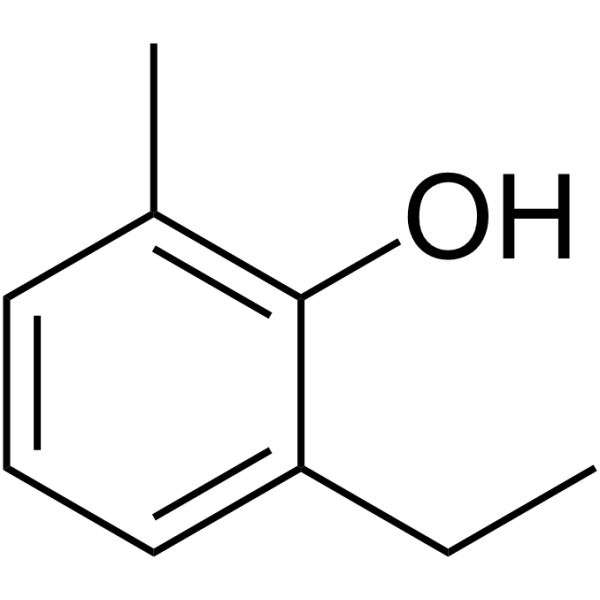Physicochemical Properties
| Molecular Formula | C9H12O |
| Molecular Weight | 136.19 |
| Exact Mass | 136.089 |
| CAS # | 1687-64-5 |
| Related CAS # | 25750-50-9 |
| PubChem CID | 519333 |
| Appearance | Light yellow to yellow liquid |
| Density | 0.994g/cm3 |
| Boiling Point | 209.8ºC at 760mmHg |
| Flash Point | 90.7ºC |
| Vapour Pressure | 0.137mmHg at 25°C |
| Index of Refraction | 1.531 |
| LogP | 2.263 |
| Hydrogen Bond Donor Count | 1 |
| Hydrogen Bond Acceptor Count | 1 |
| Rotatable Bond Count | 1 |
| Heavy Atom Count | 10 |
| Complexity | 101 |
| Defined Atom Stereocenter Count | 0 |
| SMILES | O([H])C1=C(C([H])([H])[H])C([H])=C([H])C([H])=C1C([H])([H])C([H])([H])[H] |
| InChi Key | CIRRFAQIWQFQSS-UHFFFAOYSA-N |
| InChi Code | InChI=1S/C9H12O/c1-3-8-6-4-5-7(2)9(8)10/h4-6,10H,3H2,1-2H3 |
| Chemical Name | 2-ethyl-6-methylphenol |
| HS Tariff Code | 2934.99.9001 |
| Storage |
Powder-20°C 3 years 4°C 2 years In solvent -80°C 6 months -20°C 1 month |
| Shipping Condition | Room temperature (This product is stable at ambient temperature for a few days during ordinary shipping and time spent in Customs) |
Biological Activity
| References |
[1]. Alkylphenols and arylnitriles in a biologically active neutral subfraction of cigarette smoke condensate. Phytochemistry. 1971 May; 10(5): 1135-1140. [2]. Insecticidal and bactericidal characteristics of the bio-oil from the fast pyrolysis of coffee grounds. Journal of Analytical and Applied Pyrolysis. 2011 Mar; 90(2): 224-231. |
| Additional Infomation | 6-Ethyl-o-cresol is a hydroxytoluene. |
Solubility Data
| Solubility (In Vitro) | DMSO : 100 mg/mL (734.27 mM) |
| Solubility (In Vivo) |
Solubility in Formulation 1: ≥ 2.5 mg/mL (18.36 mM) (saturation unknown) in 10% DMSO + 40% PEG300 + 5% Tween80 + 45% Saline (add these co-solvents sequentially from left to right, and one by one), clear solution. For example, if 1 mL of working solution is to be prepared, you can add 100 μL of 25.0 mg/mL clear DMSO stock solution to 400 μL PEG300 and mix evenly; then add 50 μL Tween-80 to the above solution and mix evenly; then add 450 μL normal saline to adjust the volume to 1 mL. Preparation of saline: Dissolve 0.9 g of sodium chloride in 100 mL ddH₂ O to obtain a clear solution. Solubility in Formulation 2: ≥ 2.5 mg/mL (18.36 mM) (saturation unknown) in 10% DMSO + 90% (20% SBE-β-CD in Saline) (add these co-solvents sequentially from left to right, and one by one), clear solution. For example, if 1 mL of working solution is to be prepared, you can add 100 μL of 25.0 mg/mL clear DMSO stock solution to 900 μL of 20% SBE-β-CD physiological saline solution and mix evenly. Preparation of 20% SBE-β-CD in Saline (4°C,1 week): Dissolve 2 g SBE-β-CD in 10 mL saline to obtain a clear solution. Solubility in Formulation 3: ≥ 2.5 mg/mL (18.36 mM) (saturation unknown) in 10% DMSO + 90% Corn Oil (add these co-solvents sequentially from left to right, and one by one), clear solution. For example, if 1 mL of working solution is to be prepared, you can add 100 μL of 25.0 mg/mL clear DMSO stock solution to 900 μL of corn oil and mix evenly. (Please use freshly prepared in vivo formulations for optimal results.) |
| Preparing Stock Solutions | 1 mg | 5 mg | 10 mg | |
| 1 mM | 7.3427 mL | 36.7134 mL | 73.4268 mL | |
| 5 mM | 1.4685 mL | 7.3427 mL | 14.6854 mL | |
| 10 mM | 0.7343 mL | 3.6713 mL | 7.3427 mL |
